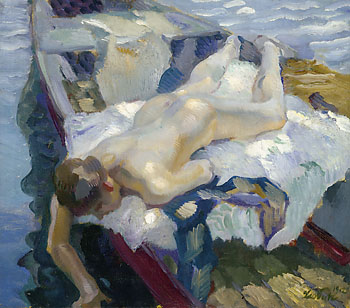
(incl. surcharge)
Auf dem Kahn
Das Gemälde wird von dem Enkel des Künstlers, Herrn Leo Putz, Gauting in den in Vorbereitung befindlichen Nachtrag des Werkverzeichnisses aufgenommen
PROVENIENZ: Privatsammlung Portugal.
Vor allem in seinen Badeszenen, diesen reizvollen Arrangements von Aktdarstellungen, gelingt es Putz, die Symbiose von Intimität und mentaler Versunkenheit wiederzugeben. Die hier gezeigte Szene erhält ihren besonderen Reiz durch die zahlreichen, changierenden blauen und grauen Nuancen, die das Inkarnat der jungen Frau modellieren. Kühle Blautöne deuten eine morgendliche Stimmung an, die noch schwachen Sonnenstrahlen werden in zartem Ocker gegeben. Neutrales Weiß, das der Künstler häufig in den Bildgegenständen verwendet, wird stets mit den umgebenden Lokalfarben gebrochen. Die Faszination für den weiblichen Akt drückt sich bei Putz in den zahlreichen Variationen des häufig gleichen Motivs aus, jedoch unterscheiden sie sich stets in ihrer Atmosphäre, durch die Tageszeit oder die Lichtführung in der Komposition: "Die schönsten Beleuchtungen fesseln mich, das sind Beleuchtungen die sich verschlingen und nur im letzten Augenblick festzuhalten sind. Die Farbe, wie sie gerade in dieser momentanen Beleuchtung erscheint und weiter gar nicht festzuhalten ist, reizt mich [...]" (zit. aus: Ruth Stein, Leo Putz, Wien 1974, S. 39).
Öl auf Leinwand , 1912
Nicht bei Putz. Rechts unten signiert und datiert. Rückseitig links auf dem Rahmen von anderer Hand bezeichnet "Akt auf Boot". 65 x 74 cm ( 25,5 x 29,1 in).
(incl. surcharge)
Headquarters
Joseph-Wild-Str. 18
81829 Munich
Phone: +49 89 55 244-0
Fax: +49 89 55 244-177
info@kettererkunst.de
Louisa von Saucken / Undine Schleifer
Holstenwall 5
20355 Hamburg
Phone: +49 40 37 49 61-0
Fax: +49 40 37 49 61-66
infohamburg@kettererkunst.de
Dr. Simone Wiechers / Nane Schlage
Fasanenstr. 70
10719 Berlin
Phone: +49 30 88 67 53-63
Fax: +49 30 88 67 56-43
infoberlin@kettererkunst.de
Cordula Lichtenberg
Gertrudenstraße 24-28
50667 Cologne
Phone: +49 221 510 908-15
infokoeln@kettererkunst.de
Hessen
Rhineland-Palatinate
Miriam Heß
Phone: +49 62 21 58 80-038
Fax: +49 62 21 58 80-595
infoheidelberg@kettererkunst.de
We will inform you in time.




 Lot 22
Lot 22 